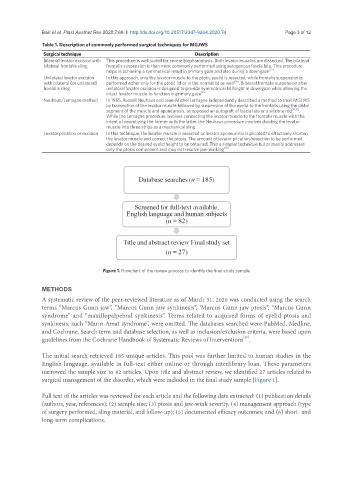Page 799 - Read Online
P. 799
Bair et al. Plast Aesthet Res 2020;7:68 I http://dx.doi.org/10.20517/2347-9264.2020.74 Page 3 of 12
Table 1. Description of commonly performed surgical techniques for MGJWS
Surgical technique Description
Bilateral levator excision with This procedure is well suited for severe blepharoptosis. Both levator muscles are dissected. The bilateral
bilateral frontalis sling frontalis suspension is then most commonly performed using autogenous fascia lata. This procedure
helps in achieving a symmetrical result in primary gaze and also during a downgaze [13]
Unilateral levator excision In this approach, only the levator muscle to the ptotic eyelid is resected, while frontalis suspension is
with bilateral (or unilateral) performed either only for the ptotic lid or in the normal lid as well [14] . Bilateral frontalis suspension after
frontalis sling unilateral levator excision is designed to provide symmetrical lid height in downgaze while allowing the
intact levator muscle to function in primary gaze [16]
Neuhaus/Lemagne method In 1985, Russell Neuhaus and Jean-Michel Lemagne independently described a method to treat MGJWS
by transection of the levator muscle followed by suspension of the eyelid to the frontalis using the distal
segment of the muscle and aponeurosis, as opposed an autograft of fascia lata or a silicone rod [11,12] .
While the Lemagne procedure involves connecting the levator muscle to the frontalis muscle with the
intent of neurotizing the former with the latter, the Neuhaus procedure involves dividing the levator
muscle into three strips as a mechanical sling
Levator plication or excision In this technique, the levator muscle is resected or levator aponeurosis is plicated to effectively shorten
the levator muscle and correct the ptosis. The amount of levator plication/resection to be performed
depends on the desired eyelid height to be obtained. This a simpler technique but primarily addresses
only the ptosis component and may not resolve jaw-winking [15]
Figure 1. Flowchart of the review process to identify the final study sample
METHODS
A systematic review of the peer-reviewed literature as of March 31, 2020 was conducted using the search
terms “Marcus Gunn jaw”, “Marcus Gunn jaw synkinesis”, ‘Marcus Gunn jaw ptosis”, “Marcus Gunn
syndrome” and “maxillopalpebral synkinesis”. Terms related to acquired forms of eyelid ptosis and
synkinesis, such “Marin-Amat syndrome”, were omitted. The databases searched were PubMed, Medline,
and Cochrane. Search term and database selection, as well as inclusion/exclusion criteria, were based upon
[20]
guidelines from the Cochrane Handbook of Systematic Reviews of Interventions .
The initial search retrieved 185 unique articles. This pool was further limited to human studies in the
English language, available in full-text either online or through interlibrary loan. These parameters
narrowed the sample size to 82 articles. Upon title and abstract review, we identified 27 articles related to
surgical management of the disorder, which were included in the final study sample [Figure 1].
Full text of the articles was reviewed for each article and the following data extracted: (1) publication details
(authors, year, references); (2) sample size; (3) ptosis and jaw-wink severity, (4) management approach (type
of surgery performed, sling material, and follow-up); (5) documented efficacy outcomes; and (6) short- and
long-term complications.

